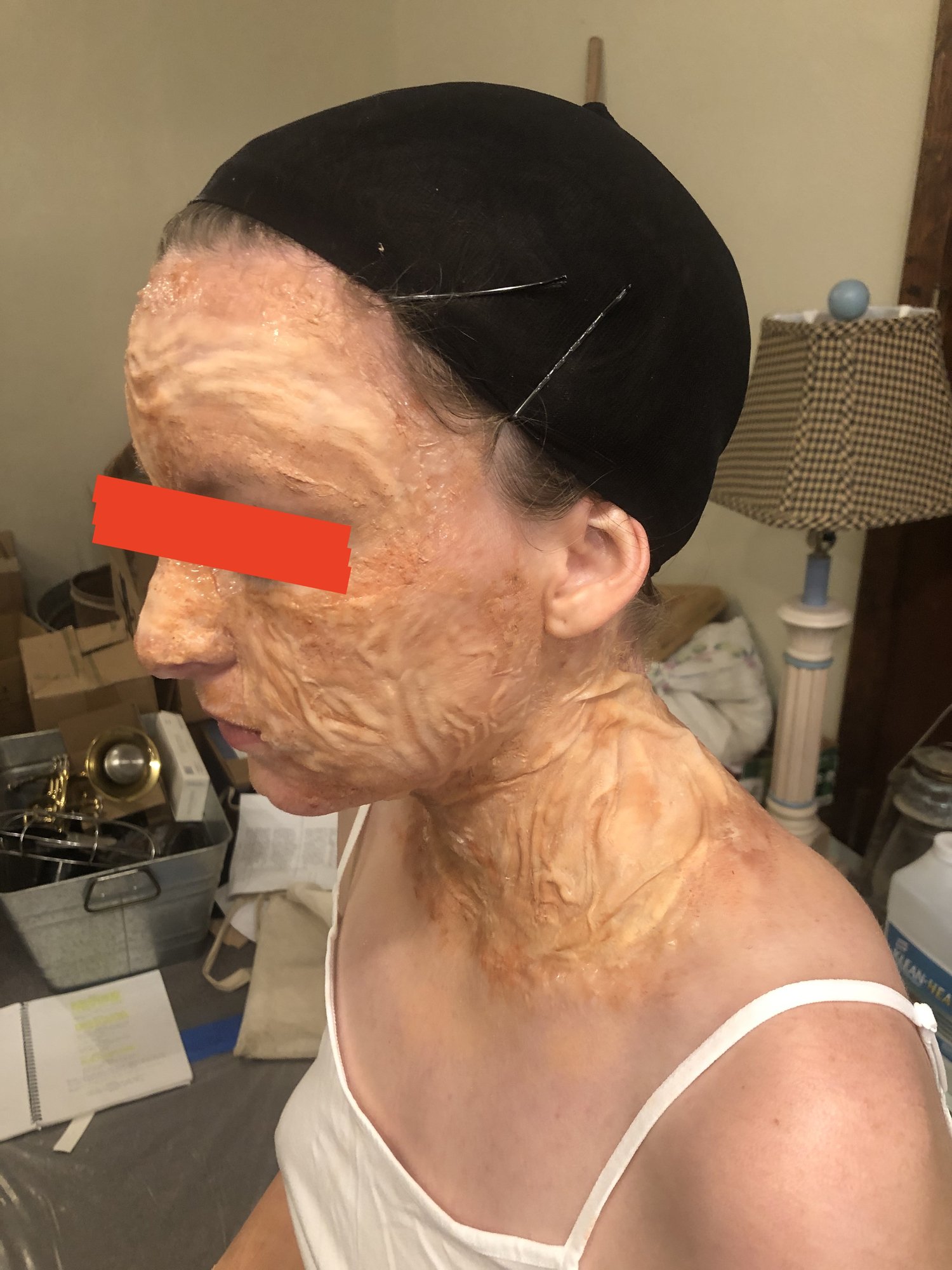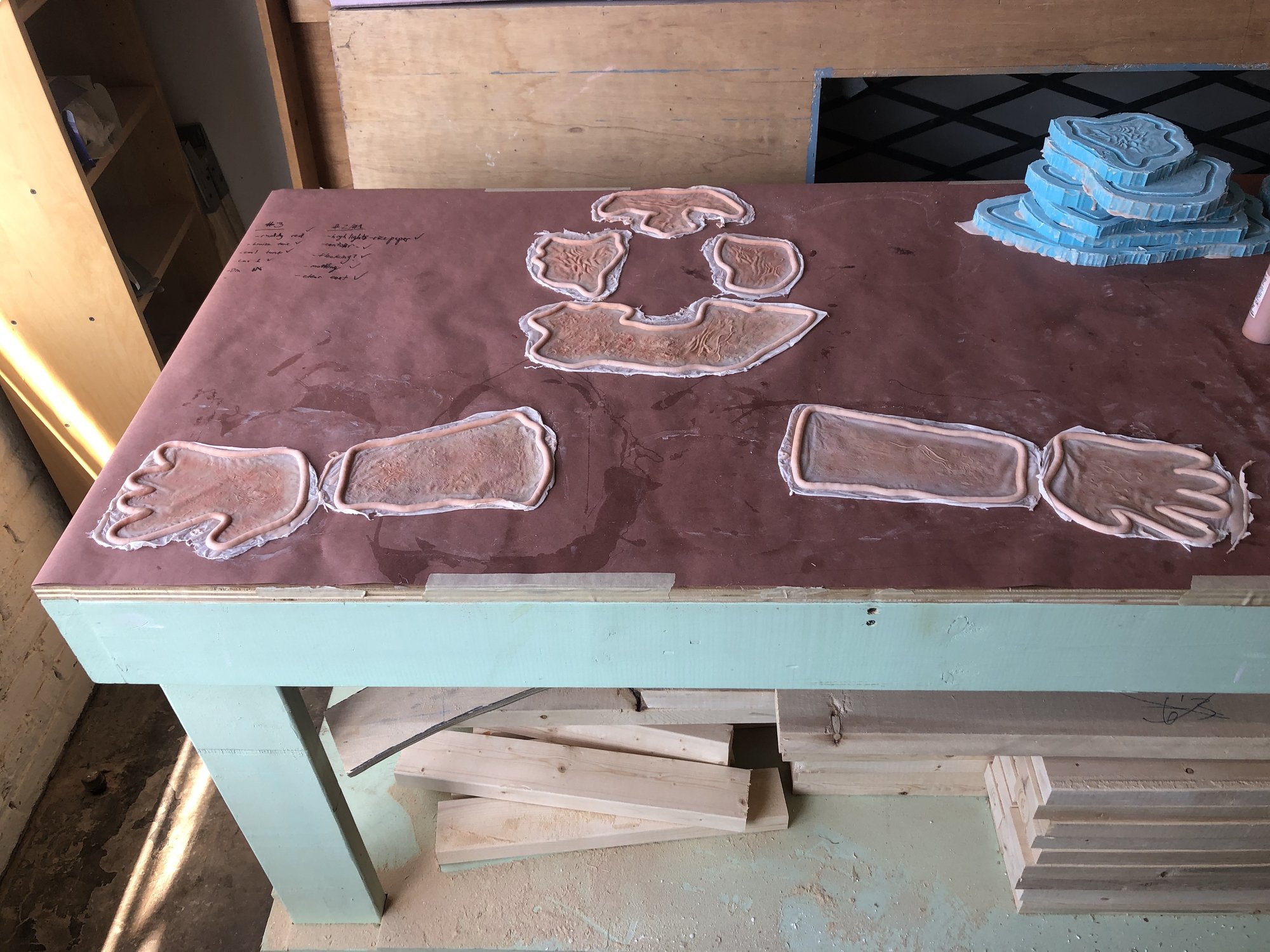Prosthetic Makeup - safety and health - skin damage
Hello,
Today I did a test application of some makeup appliances for a feature film and the actress expressed concerns about damaging her skin over the course of the shoot. Her big question - is there any chance that her skin could be damaged long term by doing this?
We start the shoot tomorrow - it's 16 shooting days and she plays in all of them with these appliances. I referenced the lessons from Neill Gorton and Bruce Spaulding Fuller when making these - there are 8 appliances covering her face, neck, fore arms, and hands. The character is covered in scars from an unexplained incident - our idea is that she was burned.
The appliances are Eco Flex Gel 2 Silicone from Smooth-On, encapsulated in Q Ballz vinyl from Smooth-On. I painted them with Skin Illustrator and applied them with Ben Nye Prosaid, used acetone as an edger, and stippled 3rd Degree around the edges. I removed it with Bond-Off and Hydra Cleanse from Ben Nye. And then she washed her face with a warm towel.
I've never heard of someone's skin being permanently damaged from prosthetic makeup, and I'm only using products designed for this work. I understand her concerns. I have definitely seen actors' skin get irritated and break out after wearing prosthetics for multiple days over the course of a shoot. I haven't done this many appliances on one actor for this many days in a row before, but I know many people have done more intense makeup's for longer runs. She has no allergies to latex or silicone. Are there any cases of people's skin getting permanently damaged by this stuff? Can anyone advise on some good practices for protecting her skin throughout this? I will try using less Prosaid during the application. Can anyone recommend a good hydrating lotion / mask to apply to her skin after the removal each night? Or other practices to take care of her skin?
Another question - I shaved her forearms before applying those pieces - she asked if her hair might grow back thicker after this - I think that is a myth. Can anyone advise on this? After today, it seems like we should also shave some baby hairs on the side of her face, like around her jaw line and by her sideburn area, as some adhesive got in there and it was painful on removal. Would shaving those hairs result in them growing back fuller or darker? Can anyone advise?
Thank you,
BenG
ps any kind/constructive thoughts on the makeup are welcome too





Today I did a test application of some makeup appliances for a feature film and the actress expressed concerns about damaging her skin over the course of the shoot. Her big question - is there any chance that her skin could be damaged long term by doing this?
We start the shoot tomorrow - it's 16 shooting days and she plays in all of them with these appliances. I referenced the lessons from Neill Gorton and Bruce Spaulding Fuller when making these - there are 8 appliances covering her face, neck, fore arms, and hands. The character is covered in scars from an unexplained incident - our idea is that she was burned.
The appliances are Eco Flex Gel 2 Silicone from Smooth-On, encapsulated in Q Ballz vinyl from Smooth-On. I painted them with Skin Illustrator and applied them with Ben Nye Prosaid, used acetone as an edger, and stippled 3rd Degree around the edges. I removed it with Bond-Off and Hydra Cleanse from Ben Nye. And then she washed her face with a warm towel.
I've never heard of someone's skin being permanently damaged from prosthetic makeup, and I'm only using products designed for this work. I understand her concerns. I have definitely seen actors' skin get irritated and break out after wearing prosthetics for multiple days over the course of a shoot. I haven't done this many appliances on one actor for this many days in a row before, but I know many people have done more intense makeup's for longer runs. She has no allergies to latex or silicone. Are there any cases of people's skin getting permanently damaged by this stuff? Can anyone advise on some good practices for protecting her skin throughout this? I will try using less Prosaid during the application. Can anyone recommend a good hydrating lotion / mask to apply to her skin after the removal each night? Or other practices to take care of her skin?
Another question - I shaved her forearms before applying those pieces - she asked if her hair might grow back thicker after this - I think that is a myth. Can anyone advise on this? After today, it seems like we should also shave some baby hairs on the side of her face, like around her jaw line and by her sideburn area, as some adhesive got in there and it was painful on removal. Would shaving those hairs result in them growing back fuller or darker? Can anyone advise?
Thank you,
BenG
ps any kind/constructive thoughts on the makeup are welcome too





0
Comments
- Allergies or reactions to a product. Ask them about their skin chemistry, if it is generally dry, oily, sensitive, or if they have products they have had negative reactions or allergies to in the past. Then work around their unique needs.
- Improper hygiene practice. Always use clean brushes and don't "double-dip" into makeups/materials for multiple actors, wash your hands, and sterilize your equipment.
- Improper makeup removal. Never rush, take your time, and be super-mindful of how much stress you are putting their skin through. Something as simple as gentle rubbing with a makeup sponge can cause damage over a long enough period of time. Find out what kind of moisturizer they like to use and have some handy for after removal.
- Improper material/product use. Know exactly what you are using and how it is intended to be used. Do your homework.
- Not enough rest/healing time between frequent applications and removals.
- Lack of a good skincare routine that takes into account what the skin is going through for the application/removal.
If they have sensitive skin, will be going through a frequent application/removal cycle without time to heal between sessions, or the process of applying/wearing/removing the makeup is extra taxing, you can use a product like "derma shield" as a protective barrier between the skin and adhesives/prosthetics/makeups.This is just a quick list off the top of my head, and I'm sure I'm missing a few things! And if you have any serious concerns or questions, don't be afraid to consult a dermatologist.
Hair growing back thicker after shaving is indeed a myth. It may have the appearance of being thicker initially because the natural tapered end to the hair will be gone, but over time everything returns to normal.
Best of luck!
/Chris
Thank you,
BenG
Plumping her cheeks with 3rd degree sounds like it would be difficult. Getting the shape even enough, stamping in pore texture, blending it, painting it.
One option would be to borrow a technique from the medical/dental world and make some cheek plumper dental appliances that push the cheeks outward from inside.
Also depends on the nature of the shots and the expectations of the actor, as dental appliances can change speech and may require some practice to get the performance down.
Something similar was done on Marlon Brando for The Godfather, just on the lower jaw.
If you have access to a vacuum former that could speed up the appliance creation process. Get an alginate mold of her upper teeth, cast a stone positive, vacuum from a clear shell over it, trim away the unwanted areas, sand the edges nice and smooth, and add material to plump the cheeks as desired. Just make sure all materials are safe/approved and every edge is polished smooth to prevent irritation.
If you don't have enough time, another option would be to quickly fabricate a dental appliance using thermoformed plastic. I use a brand called InstaMorph. They start out as white plastic beads, and when added to hot water they can be formed like clay, reheated, reformed, etc. Once done, they can be trimmed, sanded, and gently heat polished to get a smooth surface. Just make sure it's not too hot when forming them over your actor's teeth.
A similar product is used with some of the more "high-end" Halloween fangs/teeth to form and hold them to your own teeth, so if you want to go this route and don't have time to get something like InstaMorph off Amazon, or can't find a similar thermoplastic in art stores (they may have it), you could pick up a few sets of the fangs at a Halloween shop and just use their thermoplastic. Though that would cost around 10x as much.
You could also order cheek appliances from a company like RB Effects if you had more time.
/Chris